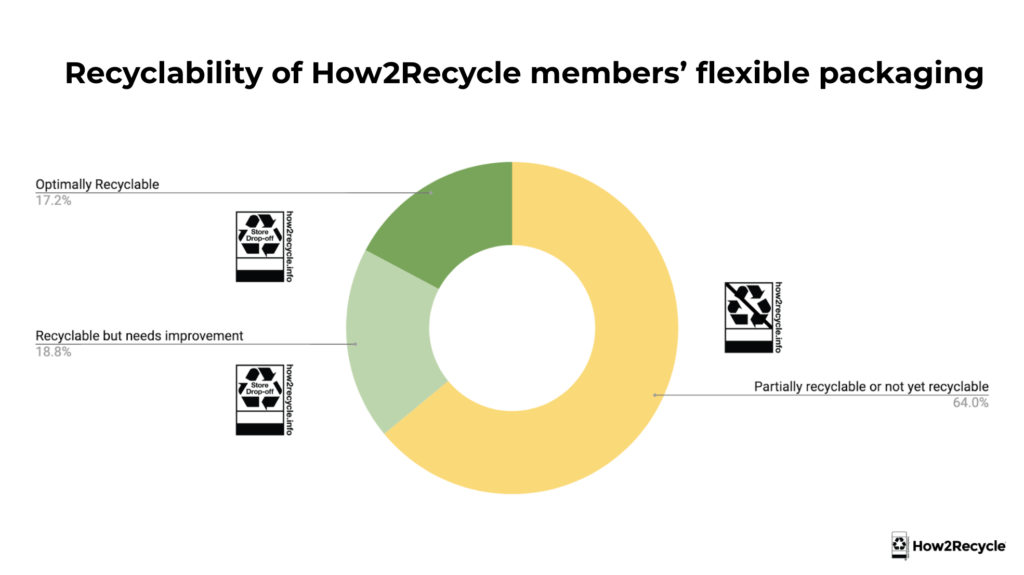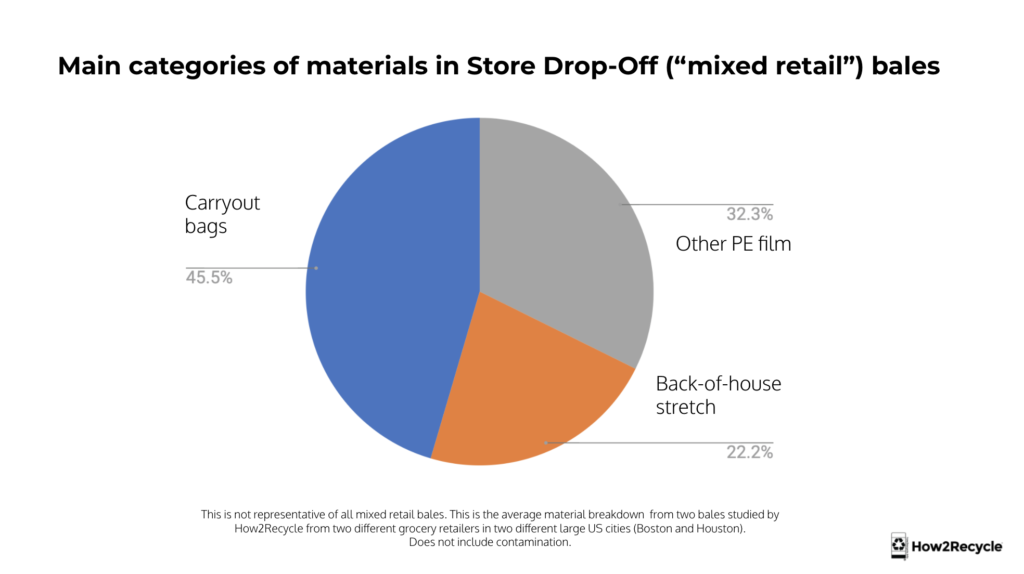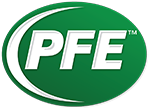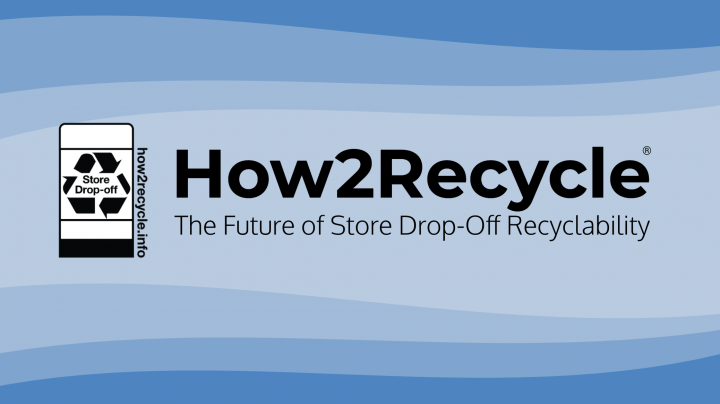Latest Articles
Every day, brands and packaging producers submit detailed packaging specifications to How2Recycle®, and the program assesses the recyclability of each packaging type and issues specific recommendations for design improvement. On average, the How2Recycle program issues recyclability labels to brands and retailers for over 225 products every day. Of those, about 10% include the Store Drop-Off label.
How2Recycle has completed an in-depth study on Store Drop-Off recyclability, and is pleased to share the results for the benefit of the general public in this report.
Contents
- What is Store Drop-Off?
- The recyclability challenge for flexible packaging
- What is the How2Recycle Store Drop-Off Recyclability Film Study?
- Design and phases of the study
- Key findings on the Store Drop-Off stream
- Key findings on PE film innovations
- What did How2Recycle learn about the test protocol design?
- Key takeaways
- Why did How2Recycle adopt the APR Critical Guidance protocol?
- What does this mean for How2Recycle members?
What is Store Drop-Off?
The Store Drop-Off label applies to certain flexible polyethylene (PE) film packaging, such as bags, wraps and pouches. Through Store Drop-Off recycling, consumers can take items featuring this label—like the wrap around paper towels, produce bags or certain stand up pouches—to their local participating retail location to recycle along with any plastic shopping bags.
Every day, brands and packaging producers submit detailed packaging specifications to How2Recycle®, and the program assesses the recyclability of each packaging type and issues specific recommendations for design improvement. On average, the How2Recycle program issues recyclability labels to brands and retailers for over 225 products every day. Of those, about 10% include the Store Drop-Off label.
How2Recycle has completed an in-depth study on Store Drop-Off recyclability, and is pleased to share the results for the benefit of the general public in this report.
Contents
- What is Store Drop-Off?
- The recyclability challenge for flexible packaging
- What is the How2Recycle Store Drop-Off Recyclability Film Study?
- Design and phases of the study
- Key findings on the Store Drop-Off stream
- Key findings on PE film innovations
- What did How2Recycle learn about the test protocol design?
- Key takeaways
- Why did How2Recycle adopt the APR Critical Guidance protocol?
- What does this mean for How2Recycle members?
What is Store Drop-Off?
The Store Drop-Off label applies to certain flexible polyethylene (PE) film packaging, such as bags, wraps and pouches. Through Store Drop-Off recycling, consumers can take items featuring this label—like the wrap around paper towels, produce bags or certain stand up pouches—to their local participating retail location to recycle along with any plastic shopping bags.

Accordingly, flexible packaging is far and away the biggest and most challenging recyclability challenge facing brands. The marketplace is experiencing an unprecedented explosion in flexible packaging, most of which is not recyclable. This is almost half the entire challenge for companies to hit recyclability goals (see the Recyclability Insights report for more detail). While some product categories can be very easily changed to Store Drop-Off packaging today, others, such as those containing wet and sticky products or those requiring a very high performance barrier, require recycling system interventions. These interventions may include new or different collection mechanisms for reprocessing technologies like chemical recycling. See the “Considerations for far future recyclability” section of the How2Recycle Guide to Future Recyclability for more detail.
However, the ability of the Store Drop-off stream to alleviate the packaging industry’s end-of-life challenges with flexible packaging is limited long term. Like all recycling streams, market volatility in the global commodities context is a challenge. But for Store Drop-off in particular, the demand for the material, its current recycling rates, and the challenges inherent in Store Drop-off collection (consumer convenience, reliance on retailer participation), along with the enormous volumes of flexible packaging that are being produced, suggest that its long term potential for all or most flexible packaging is insufficient to meet recovery needs. Accordingly, How2Recycle recommends that brands, packaging producers and resin manufacturers critically analyze what wide-reaching collection, sortation, reprocessing and market mechanisms and investments are required to scale recyclability of flexible packaging for the far future. See the How2Recycle Guide to Future Recyclability for more insight.
Still, many packages that are Not Yet Recyclable today could be moved to Store Drop-Off recyclable material, and much of that is low hanging fruit from an implementation perspective.
PE film provides excellent moisture barrier, is transparent, and carries a lower carbon footprint than most rigid packaging. For this reason, it is potentially suitable for many packaging applications. Too many companies are still using nonrecyclable plastic films (made of materials like polypropylene (PP), polyethylene terephthalate (PET) or a combination of resins) to package products, when Store Drop-Off recyclable PE could be used instead. The most frequent example of this is products that require no moisture barrier but are packaged in PP film—the high clarity, crinkly bags. For example, you may see PP bags for certain apparel bought via e-commerce, or bags holding individually wrapped candy. Chances are, the package design could be changed to PE so that it can be recycled via Store Drop-Off.
For other product applications that may require a certain oxygen barrier or greater strength than traditional PE film, innovation is happening at a rapid pace in the packaging industry. For example, technology in PE film packaging has enabled products like granola that previously would not have been sufficiently protected by PE pouches to become Store Drop-Off recyclable. In order to ensure that these increasingly sophisticated and fast-proliferating innovations can be labeled as Store Drop-Off recyclable, especially as flexible packaging is the fast growing segment in packaging, How2Recycle needed to learn more—and so began this study.
This How2Recycle Store Drop-Off Film Study illuminates design considerations for flexible polyethylene packaging in the present and into the future for How2Recycle member companies seeking to make more recyclable packaging.
What is the How2Recycle Store Drop-Off Recyclability Film Study?
How2Recycle launched an in-depth Store Drop-Off film study in 2018 in order to:
- Better understand the Store Drop-Off stream.
- Better understand how certain PE film innovations may impact the Store Drop-Off stream.
- Identify the most appropriate test standard for Store Drop-Off recyclability.
- Be in an informed position to provide R&D guidance to members for PE film.
Multiple phases of this study included on-site PE film recycler visits and extensive testing of current Store Drop-Off material and specific PE film innovations together with How2Recycle’s third party lab partner for this project, Plastics Forming Enterprises. Over 4100 pieces of quantitative data were generated and closely analyzed.
Design of the study
The study design focused on two key areas: first, understanding the Store Drop-Off stream, and second, understanding the potential Store Drop-Off recyclability of certain PE film innovations. For the first part of the study, to understand the current recycling stream, How2Recycle sought to answer these questions: What material is in the stream, exactly? How does that material behave as a whole? How do specific materials in the stream behave?
And for the latter question, How2Recycle asked, how do different PE film innovations behave from a material perspective? How do those materials compare to the Store Drop-Off stream? How do those materials compare to one another?
As a result of these two focus areas, How2Recycle’s goal was to identify the best way to assess PE film innovations against the stream in order to set a standard for Store Drop-Off recyclability.
Phases of the study
The need for a clearer standard and test protocol for assessing Store Drop-Off recyclability was first identified in 2017. The study began in early 2018 and ran through 2020. The current Store Drop-Off stream and specific PE film innovations were studied concurrently, and complemented by on-site visits with three PE film recyclers. Throughout this process, the scope of work was expanded to accommodate additional innovations of interest, as well as acquire greater levels of detail in lab testing than what was initially envisioned. The data gathered was continuously analyzed so that the trajectory of the study could be adjusted to new learnings.
Plastics Forming Enterprises (PFE) is an independent third party lab with significant testing expertise in plastics recyclability globally. How2Recycle worked with PFE as a partner on this project, relying on their technical knowledge and skills to not only shape the study design, but also analyze the data coming out of it with their decades of experience and science-based approach. Additionally, PFE joined How2Recycle at the reclaimer facilities for the opportunity to learn and add project value. PFE is a candidate test lab for Association of Plastic Recyclers (APR) that has worked with APR to develop several of its testing protocols for plastic packaging.
Real-life bales of Store Drop-Off material were broken up and analyzed in three locations from different retailers across the country; the types of packaging formats and contamination in the bales were assessed. In two cases, that sorted material was recombined (reflecting real world Store Drop-Off material as a whole) and turned into recycled pellet. In a third case, that material was kept separated into three different categories based on format, and the material from each format was then turned into recycled pellet. In total, over 2000 lbs of material were sorted by hand in these bale sorts.
Similarly, an array of specific PE film innovations along with resin controls were sent to PFE for analysis. The innovations to study were selected by How2Recycle, but specific formulations of those innovations (ones earmarked for potential commercialization) were selected by a handful of specific How2Recycle members with an interest in learning more about PE film recyclability. Members provided the material and covered some of the costs of testing—How2Recycle funded the rest. These materials were pelletized and analyzed.
In accordance with the forthcoming APR Critical Guidance PE film test protocol, the material properties of all the pellets were assessed through many parameters, including: extrusion pressure (psi), delta pressure, delta from first to last 5 minute pressure, melt flow rate (190 degrees C, g/10 min, 2.16 kg), density (g/cc), primary peak melt temperature, secondary peak melt temperature, peak 1 enthalpy, peak 2 enthalpy, delta enthalpy, average ash %, % volatiles (160 degrees C), color (l*, a* and b* values), bulk density (kg/m3), pellet surface appearance, impurity content, and extrusion process irregularity.
The recycled pellets were then turned into molded parts. The mechanical properties of the parts were assessed through parameters according to the APR PE film benchmark test protocol (as the APR Critical Guidance test for PE film was not completed at the time of study), including: flexural modulus (psi), delta flexural modulus, tensile strength at yield (psi), delta tensile strength, elongation at yield (%), delta elongation, notched izod impact (ft-lb/in), delta notch izod impact, and melt flow rate (190 degrees C, g/10 min, 2.16 kg).
The pellets were also then blown into films. The processing properties of the film were assessed through parameters according to the forthcoming APR Critical Guidance PE film test protocol at 50% concentration, including: tensile strength (psi), delta tensile strength, elongation at yield, delta elongation at yield, tear strength (gf), delta tear strength, tear strength with thickness calculation, delta tear strength to 1 mil, impact failure weight (Wf), delta impact failure weight, impact failure weight to 1 mil, delta impact failure weight to 1 mil, process stability (y/n), film thickness, and a film appearance rating that assessed texture, gels, carbon particles/specks/unmelts, fisheyes, holes, and breaks.
The material was turned into pellet, parts and film because those reflect different ‘end applications’ for the material. How a material performs in different applications influences who will buy the material, and for what reasons. Additionally, different end applications highlight different qualities of a material, painting a full picture of its character.
In total, 9 samples of real-world Store Drop-Off bales were assessed, as well as 10 films representing 5 innovation types across multiple concentrations. The data points from all these lab tests were closely analyzed so that innovations and Store Drop-Off bales could be compared to each other. This analysis was supplemented by qualitative data gathered at the three on-site PE film recycler visits about buy/sell behavior, contamination, recycling processes and end markets insights.
While the study is formally complete, it is not over: learning will continue indefinitely into the future as the How2Recycle program, PE film recyclers and the packaging industry learn and adapt to evolving needs, markets and information.
Concurrently with this study, the Association of Plastic Recyclers developed its Critical Guidance test protocol for PE film recyclability. The work was informed by APR member company research in similar areas and used a consensus process to validate important features of the test protocol. APR was involved in several aspects of How2Recycle’s film study, including the film sorting and review of preliminary results. Input from the How2Recycle team was considered where appropriate in development of the test protocol.
How2Recycle is pleased that this work culminated in the announcement of the program’s adoption of APR’s Critical Guidance protocol for PE films (see detail in later section).
Key findings on the Store Drop-Off stream
The Store Drop-Off stream is very diverse. There are many different packaging formats in it. The main materials seen in Store Drop-Off bales (often referred to as “mixed retail” bales) are:
- “Back of house” (predominantly LDPE stretch wrap from pallets in retail or distribution center operations), and
- “Front of house” (material from the consumer collection point at the retailer. This is where PE film labeled Store Drop-Off ends up; grouped with predominantly HDPE carryout bags, which usually constitute at least half of the front of house material).

PE film packaging from the “front of house” can take many forms, such as shrink film, case wrap, air pillows, ecommerce mailers, and pouches that may be HDPE, LDPE, LLDPE, ULDPE, or MDPE—either in monolayer or multilayer. This leads to a big variety of PE densities in the stream. Additionally, retailer and/or retailers’ employees’ behavior can contribute to variability in the material bale to bale within a location or across different retail locations.
How2Recycle’s lab analysis confirms the big variety in PE densities: some of the highest and lowest values on the exact same testing parameter came from categories within current Store Drop Off material. For example, on melt flow rate in part testing, the lowest value of all materials studied was the carryout bags from the real Store Drop-Off bale, and the highest value of all materials studied was the stretch from the real Store Drop-Off bale.
PE film recyclers each manage this diversity in their own way: they may adjust their purchase behavior, and/or have different quality control processes in place, and/or may leverage certain equipment to achieve the desired density mix. How PE film recyclers manage the incoming material depends on the needs of their end application/s, such as density, cost, and various other material or processing attributes.
Most of the contamination in the Store Drop-Off stream is from items that don’t belong there, such as PET bottles and trash placed in the front-of-house retail collection bins. This is likely due to bin location (whether other recycling and trash bins nearby), or clarity/size of signage. In all three bale audits, there were no How2Recycle Not Yet Recyclable labels on flexible plastics in the Store Drop-Off bins. This suggests that on-pack labeling is likely effective in encouraging correct Store Drop-Off recycling behavior and in discouraging contamination.
In the back-of-house, the most contamination comes from non-film items such as hangers, pallet strapping and rigid plastics from deli operations. This is likely due to insufficient or inconsistent training of employees at the retail location, as well as possibly PE film recyclers not enforcing or struggling to enforce their own bale specifications.

